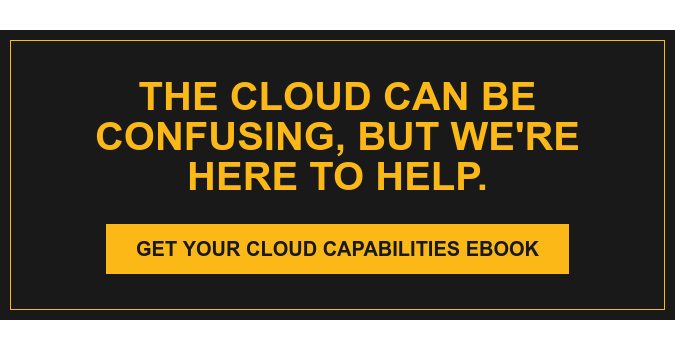Today, almost everything is happening in the cloud – if you know it or not. It’s changing the business landscape. From storage to software to security, cloud services are taking over almost every aspect of technology. If you don't embrace this new technology, you risk being left behind by forward thinking competitors.
For a high level overview of cloud computing, review our infographic. It provides a snapshot of the many ways cloud computing is (or could be) incorporated into business operations.
To view the full size infographic, click here. For a printable, high resolution view, click here .
What Is The Cloud?
The cloud is a metaphor for the internet that was born from diagrams depicting the internet as a cloud. These diagrams have been in use long before the term “cloud” evolved.
Cloud computing then evolved from this metaphor. In a very simplified manner, cloud computing is a combination of hosted applications, data storage and remote server access through the internet. Many individuals and businesses use the cloud in some format, often without knowing. Social networks and email applications are two of the most common uses.
Why Use The Cloud?
One of the primary benefits, which initiates drastic changes within organizations, is unlimited access. Everything you or your employees need is always right at your fingertips. This new capability gives your company the power to do business differently. Here are some of the key changes cloud computing enables in businesses that embrace this new technology:
- Internal IT responsibilities and accountability shift, in a positive direction
- Employees can access documents remotely and more easily collaborate with co-workers, customers, partners, etc.
- Think bigger, thanks to freed up resources, scalable services, enhanced security, focused employees and more
How Are You Currently Using the Cloud?
Many businesses use the cloud without realizing, generally on the Software as a Service (SaaS) level. The applications featured in the infographic - iTunes, Salesforce, Netflix, etc. - are all examples of SaaS, and are commonly used on the business and personal level.
Additional service levels are Platform as a Service (PaaS) and Infrastructure as a Service (IaaS). Click the brief description below to learn more about each:
- PaaS: This service level gives developers tools to create and manage apps you need to function on your systems platform; meanwhile your provider takes most of the control of your infrastructure off your hands. You are responsible for the performance of your app while the provider is responsible for storage, security, network, hardware and updates.
- IaaS: This level passes a large portion of delivering your IT infrastructure to your provider. Your cloud services provider will provide the necessary computing power and network infrastructure, data storage, ongoing patching, monitoring and end user support services necessary to run your business, which is paid on a monthly basis. It allows you to only pay for the computing power you use and the number of computer users that access it.
Top Uses of the Cloud
As the infographic displays, file sharing, file backup, business applications, website hosting and ecommerce and email are the most common ways businesses are taking advantage of cloud computing.
To dive deeper into the cloud, check out our eBook:

